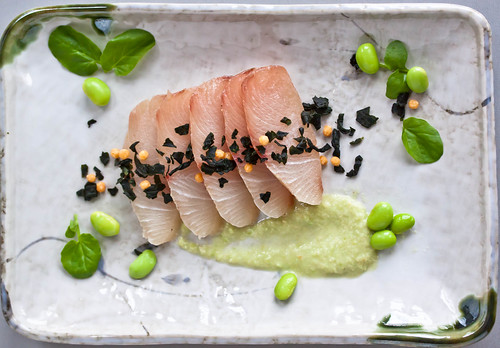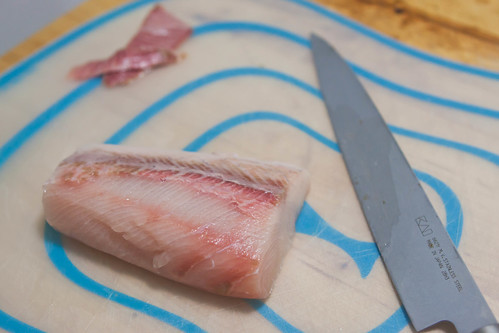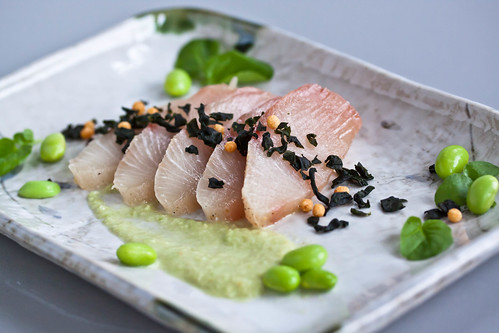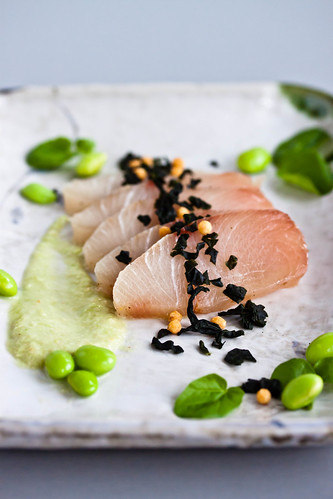NYC in late 2009 was a great trip. I’m jonesing to go again, perhaps sometime next year when I hope to also make it to another favourite eating-town, Chicago. As I’ve mentioned before, our trip to New York had turned into a bacchanalia of eating and drinking – would that our bellies were bigger, or that I had a higher tolerance for alcohol. 5 days and 4 nights just wasn’t enough to make a dent. Momofuku Ssam Bar was indeed a highlight, and one of the dishes that struck me the most for its beauty and delicacy was the cured Hamachi crudo dish.
Pale pink and pale greens, tiny crunchy yellow rice balls from the Wakame Chazuke; dramatic dried black seaweed. The dish is quite poetic. My only teeny complaint is that I wanted to taste more of that edamame-horseradish sauce, and a slight addition of acid. Luckily, we had also ordered a large plateful of pickles, so those provided a bit of acid in between bites of Chang’s other rich food.
The hamachi dish is also, fortuitously, one of the more reasonably replicated dishes in the cookbook, requiring only a 2-3 hour pre-cure of the fish. The cure is not difficult to make, as long as you have access to Sichuan Peppercorns.
I purchased a nice slab of pristine hamachi from my favourite Japanese market, Nijiya. To prep it before I sprinkled on the aromatics mixture, I made sure to cut off the dark red bloodline, using our fishknife — David Chang urges you to use the sharpest knife you have, and then make sure to sharpen again it prior to slicing the fish.
Then the cure goes on: salt, sugar, ground sichuan peppercorn. Note that the recipe calls for a 9-oz piece of fish; I must have purchased something like 6.16 oz, and there was a lot of the cure mixture left over.
Perhaps the sauce is a little more complicated – it basically contains edamame, some light-coloured usukuchi soy (Chang’s preferred type of shoyu – note that usukuchi is saltier than regular soy), grated fresh horseradish, sugar, and a bit of water. I didn’t have time to track down fresh horseradish, and settled for a jar of the prepared stuff (thankfully, I found a jar that contained only vinegar as a supplement, not one that contained eggs). Still, Chang would probably counsel against this – in another recipe for peas and horseradish he advocates against using bottled horseradish – but there were no such caveats in this particular procedure, and I forged ahead with the substitution.
I would urge you now – do not attempt to mix up the edamame sauce in your food processor, and go straight to the blender. I made the mistake of first using the processor, but it was not powerful enough to puree the edamame mixture. So I had to take out the blender after all (and deal with the mess in my mini processor).
The next step is straining the sauce. I used a chinois (Chang recommends this, using any fine mesh strainer or even a tamis). I did, but could not get the sauce to adopt the same thickish-creamy consistency we encountered at the restaurant, or what seemed to be pictured in the cookbook photo. In the end I had to add a bit of the coarser stuff that remained in the chinois to give the sauce a bit more body – so it held some sort of more elegant teardrop shape and didn’t spread out in a ramdom shapeless blob the moment I spooned it on a plate.
That sort of worked, except that the sauce no longer looked smooth. But it tasted good, and even had a nice tang from the vinegar in the horseradish.
The presentation is by the book, though instead of young pea leaves I purchased and used some upland cress. The black bits and golden balls are bits of Wakame Chazuke: a Japanese seasoning sold in bottles or packets and are traditionally intended to to be sprinkled on top of rice. The curls of black are dried seaweed, the golden bits puffed rice. These gave a nice crunch to the dish.
All in all, this is a beautiful, delicious and dramatic dish to serve for guests, or even as a snack after a run in the park. Just make sure you plan ahead for the curing period.






Pingback: Momofuku's Spicy Sausage and Rice Cakes | Tabemasu()